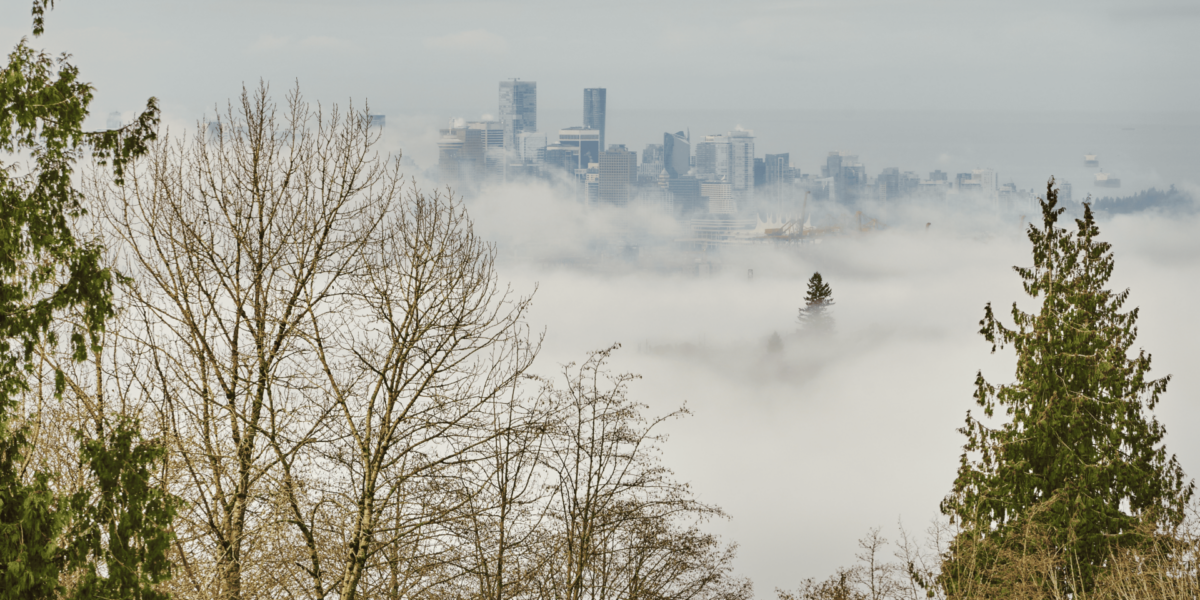Fog Alters the City’s Familiar Shapes
On foggy mornings in Vancouver, buildings lose their outlines. Streets stretch into soft blur. The city changes its edges and hides its usual scale. What was once defined becomes uncertain.
A commuter walks toward the skyline, but only sees outlines. The tops of towers vanish into low clouds. The fog doesn’t erase the city—it reshapes how people see it. This temporary veil shifts perspective.
Movement Slows in Low Visibility
Fog reduces speed. Drivers press brakes sooner. Pedestrians glance longer before crossing. Movement becomes cautious. The city’s usual flow softens into deliberate steps.
A cyclist coasts through a quiet intersection, checking twice before turning. Traffic sounds muted. Routine actions slow down. The fog turns every motion into a measured response.
Sound Gains Clarity When Sight Shrinks
With less to see, sound steps forward. Tires on wet pavement, boots against sidewalk, birds in bare trees—all stand out more clearly. The city sounds louder without being busier.
A resident walks through a park as a dog barks in the distance. The noise travels farther than usual. The fog doesn’t just mute—it isolates. It gives sound more space to move.
Light Behaves Differently in the Fog
Sunlight spreads wide and flat across fog. It doesn’t cast strong shadows or highlight sharp lines. Instead, it creates glow. Colors soften. Contrast fades. Light in fog becomes texture.
A café opens with dim bulbs glowing in the window. The warm light doesn’t compete with daylight—it blends into it. In fog, the brightness of a lamp feels like part of the weather.
Vancouver’s Geography Becomes a Canvas
The fog interacts with the city’s mountains, trees, and water. Peaks vanish. Bridges emerge halfway. The landscape becomes a series of scenes revealed in slow sequence.
A ferry crosses Burrard Inlet. One bank disappears behind mist. The other emerges in layers. The view isn’t gone—it’s rearranged. Fog doesn’t block—it reveals by degrees.
Routine Spaces Feel Unfamiliar
Fog changes the emotional tone of everyday places. A street someone walks daily feels deeper. A storefront looks different. The loss of visibility adds weight to simple views.
A student approaches their school. The building seems further away. Sounds echo differently. The usual route feels like a new path. The fog creates a sense of distance in a short space.
Reflection Becomes Part of the Experience
In fog, the pace slows, and the world narrows. Thoughts shift inward. The weather encourages reflection without requiring isolation. The city still moves, but more softly.
An early riser waits for a bus. There’s no rush, no hurry in line. The fog dims the noise. Morning becomes more personal, less public. The weather allows quiet without creating silence.
Photographic Detail Shifts With Atmosphere
Vancouver photographers often work with fog, not against it. In the morning mist, shapes flatten and soften. Shadows disappear. What the image lacks in clarity, it gains in tone.
A photo of a dock shows fewer details, but more mood. The image doesn’t reveal everything. Instead, it invites the viewer to stay with it. Fog gives photography texture through absence.
People Navigate the Mood, Not Just the Weather
Morning fog creates more than visual change. It shifts mood. People respond to it with their bodies, clothes, posture, and pace. The emotional atmosphere of the city changes with the mist.
A group waits outside a station in quiet conversation. The fog shapes how they speak, how they stand, how they look around. The weather doesn’t press on them—it softens their presence.
Fog Doesn’t Hide—It Reveals Differently
Vancouver’s foggy mornings don’t erase the city. They expose it in pieces. The skyline fades, but new textures appear. Light, sound, and pace shift. The city becomes something else—but still itself.
What fog reveals is a quieter Vancouver. One shaped by reflection, motion, and atmosphere. The mist doesn’t just cover—it reshapes how people engage with place. And through that lens, the city offers a different kind of clarity.

